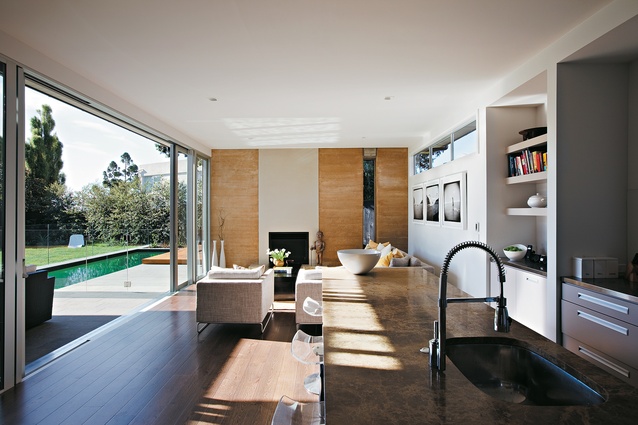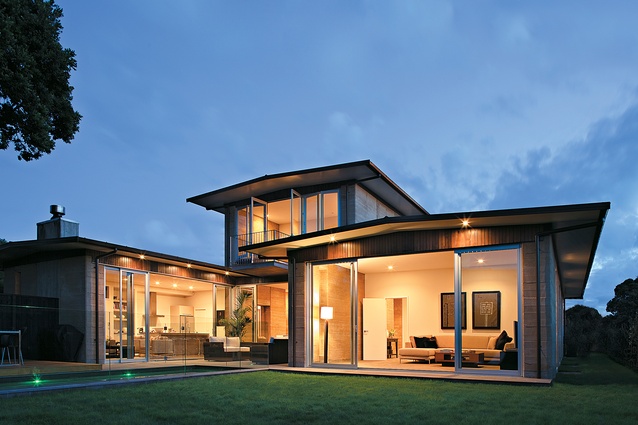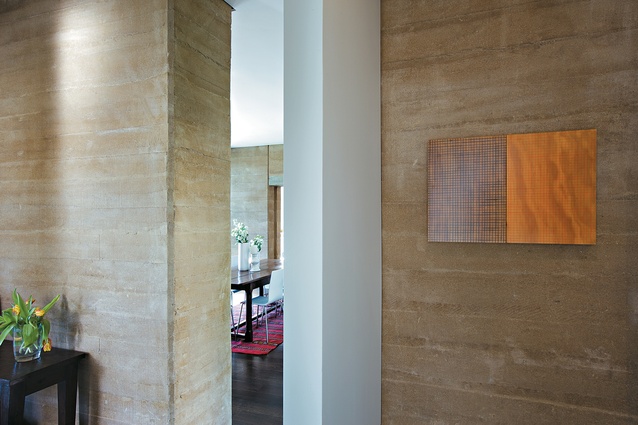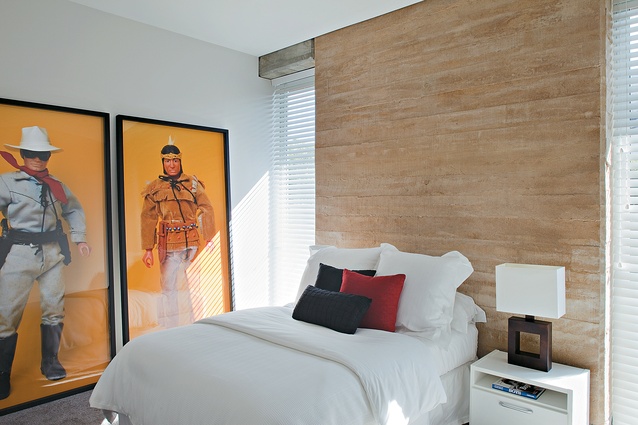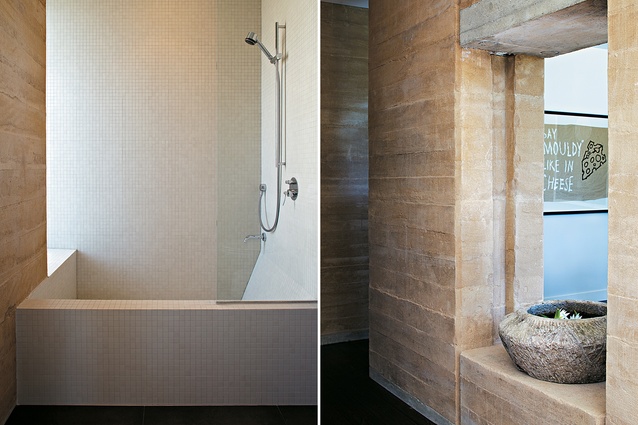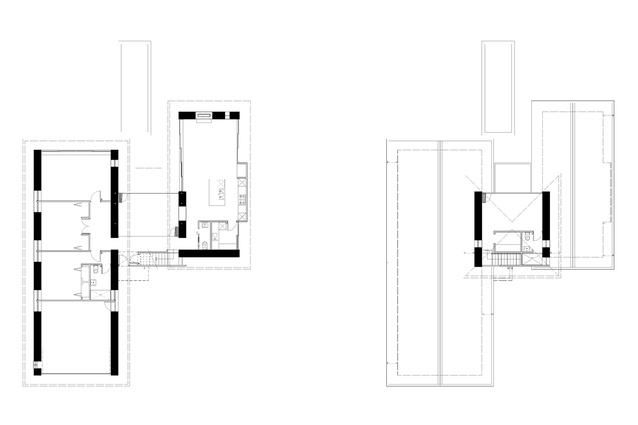Houses Revisited: Down to earth
Revisit a home in an Auckland inner-city suburb where architect Megan Rule works with the oldest material of all.
In first meeting with Megan Rule, director of South Pacific Architecture and architect of this house, it was surprising to me that this petite, softly-spoken and reserved woman could be the author of something so heavy and massive. After a few minutes of speaking to her, however, and after looking at the building’s finer details, I began to realise that it was not the first impressions of this house that were of particular interest to her; they are simply the outcome of a thorough investigation into using earth as a basic construction material.
Rule had never built with earth before. As she explains, “you’re not offered many opportunities to build with it, as it is a construction type that presents many issues in the city”. But, having always had an interest in working with earth and exploring its method of construction as an way of understanding other building materials, she proposed using rammed earth when the clients approached her to design a house on a section in the Auckland inner-city suburb of Westmere.
Rule believed the idea was feasible due to the reasonably sized and flat site. The size and slope of sections are factors that tend to hinder the use of rammed earth construction, especially in the city. The additional wall thickness that is required with rammed earth walls takes up a lot of useable space – Rule calculated that the walls in this house, if placed alongside each other, would occupy the space of a large double garage.
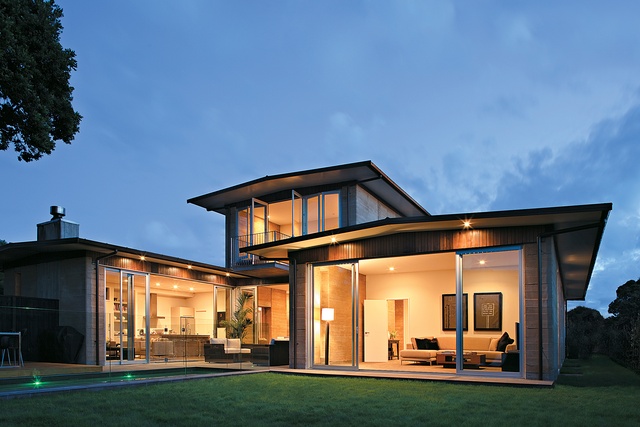
Also, to protect the walls of rammed earth houses, roof overhangs must be much larger than those deployed on standard construction types. This requirement forces the house to be stepped further back from boundary lines. Together, the thickness of the walls and the extent of the overhangs mean that site space can be rapidly occupied without much living space being accommodated.
As neither the architect nor the contractors involved with the project had previously worked with rammed earth, the process of creating the building was very much about learning basic techniques. By using earth from a company on the west coast of Auckland that already constructs earth bricks, Rule and the contractors were able to minimise research time. Using earth that was already known to be suitable for building – the consistency of various earths drastically affects the stability of the final material – meant that they were able to eliminate one of the project’s many unknown factors.
The technicalities of building a house out of rammed earth dictates many of the planning and spatial elements. In this project, too, the design had to accommodate the clients’ request for a semi-enclosed courtyard area at the back of the section. These considerations led to a relatively simple plan comprising two wings: one that integrates the living spaces, and the other linking the two bedrooms and study or second living space.
The two wings are connected by the main entrance space and a room used as the dining room, a layout Rule describes as “a subtle reference to the historical grand hall”. Upstairs is the master bedroom, which catches glimpses of the Waitemata harbour. Because the roofs of the wings below can be seen from this space, the wings are comprehended as being integral to the design.
Rule describes the roofs as part of the landscape: “In contrast to the massive walls they sit low in profile. They undulate and with the ribbed surface they hint at a reference to the wider context of the site as well as an imagined landscape”.
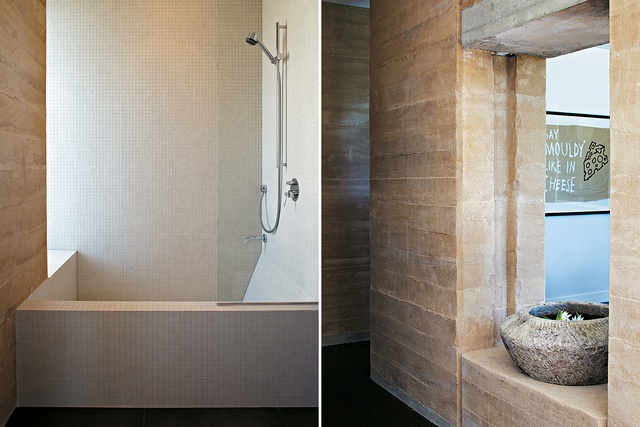
In this project Rule explains that she was interested in the overlaying of spaces. This intention has been realised; although the house is reasonably spread out, there is always a perception of connection to far-away spaces. The rhythm and spaces set up by the rammed earth walls – partly caused by Rule’s aversion to the aesthetics of a wall section joint, which requires an angled and reasonably deep reveal – means that peepholes are created, which artfully connect various spaces.
All of the rooms feature the rammed earth walls, and are typically contrasted against full height glazing. Along the western exterior of the façade, the rhythm set up by succession of mass walls and glass appears as a subtle reference to an ancient European colonnade. In contrast, from the interior the juxtaposition of bright light against the earth walls highlights the walls’ more delicate features.
The process of constructing a house primarily from rammed earth is intensive and unforgiving – every part of the process of getting the walls up seems to be marked on the building forever. “In some ways you need to accept it is a natural material and there will always be inherent faults within the product,” Rule says.
There was no point fighting against the nature of the material. Instead, Rule has chosen to emphasise the roughness of the walls. Using timber with a rough, band-sawn finish for the walls’ formwork, and not using a finish on the walls, which can be clear sealed, serves to highlight the rawness of the material. It is these inconsistencies, and marks on the walls, that create the most interest in this project.
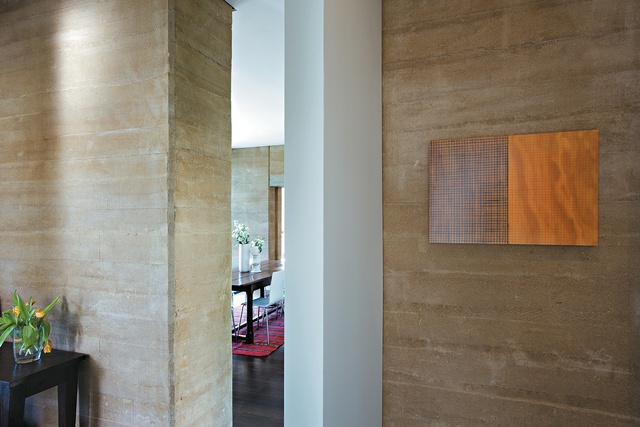
The conscious decision to make the walls 600 millimetres deep, rather than the required 300 millimetres, means that the walls’ formwork was more accessible – the contractors were able to get inside the formwork during construction of the walls. The thickness accentuates the solidity of the walls, and you are able to readily recognise their weight.
Rule describes the mass as a poetic idea of a building’s life cycle: “This earth is not easy to move and in places such as Europe, buildings made out of this stuff have been around for hundreds of years. It is interesting to think about the rest of the building deteriorating, with the earth walls still here, and the building being reinvented using them”.
The weight of the building prompts a certain feeling and mood; it heightens the senses. “You begin to consider what this building is made of, rather than what you can just see,” Rule says. People who come to this place are forced to become intensely aware of their surroundings; it is a tactile building, not simply a massive one.
This article first appeared in Houses magazine.


